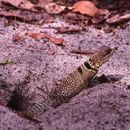Biology
provided by Arkive
This spiky-tailed iguana is primarily arboreal, or tree-dwelling, and spends much of its time gripping to trunks and branches, where they remain motionless as they scan the surrounding area for prey. When the collared iguana spots an insect, their primary food source, they ambush it, moving quickly to capture it on a nearby tree surface or running to the ground to attack. Collared iguanas have also been observed positioning themselves near an ant trail where they can gain an easy meal by picking up the ants one by one. Occasionally, collared iguanas also eat plant matter, such as flowers found on the ground (6). When threatened by a bird of prey or a predatory snake, the collared iguana will retreat into a crack or crevice in a tree trunk, and use its armoured tail to form a barrier between itself and the predator (4).
Collared iguanas lay their eggs after the first heavy rain of the rainy season. The female digs a hole, up to around 12 centimetres deep, in open ground where there is no live vegetation, often on a man-made forest trail. Into this hole the female lays a clutch of two to five eggs, with three or four eggs being the most common clutch size. The female then fills the hole with sandy soil and covers the nest with sand, dead leaves and twigs, so that the laying site blends into the surroundings. The female then immediately leaves the nest site. Despite the collared iguana's efforts at disguising the nest, they are still uncovered by snakes, such as the Malagasy giant hognose snake (Leioheterodon madagascariensis), which has been seen digging up and eating the collared iguana's eggs. If the eggs survive predation, they will remain in the nest for 61 to 71 days at a temperature of 29 to 31 °C before hatching (7).
Conservation
provided by Arkive
There are no known conservation measures currently in place for the collared iguana.
Description
provided by Arkive
The collared iguana is the most common lizard species in the western forests of Madagascar and the largest species in the Opluridae family (3). It is named for the distinctive black collar that stands out against the greyish-brown body, which is speckled with lighter spots. This iguana species has a robust, flattened build, with a chunky head and a relatively short tail, which bears spiny whorled scales down its length (2) (4). Female collared iguanas are duller in colour than males (4).
Habitat
provided by Arkive
The collared iguana inhabits tropical forest and rainforest (4).
Range
provided by Arkive
Occurs in north-western Madagascar and on Grand Comore Island. There are two subspecies: Oplurus cuvieri cuvieri is found in north-western Madagascar from western Diego-Suarez Province southward into northern Tulear Province, and inland to the western slopes of the Tananarive Province, with an isolated population in north-western Fianarantsoa Province. Oplurus cuvieri comorensis occurs only on Grand Comore Island, westward of the northern coast of Madagascar in the northern Mozambique Channel (5).
Status
provided by Arkive
This species has not yet been assessed by the IUCN.
Threats
provided by Arkive
The collared iguana has not yet been assessed by the IUCN and therefore it is not clear whether this species is threatened with extinction, and if so, what threats it faces. However, the forests of Madagascar face a number of threats which may be impacting on this iguana; this includes the burning of forests for the expansion of agricultural lands and the exploitation of trees for timber and charcoal (8).

